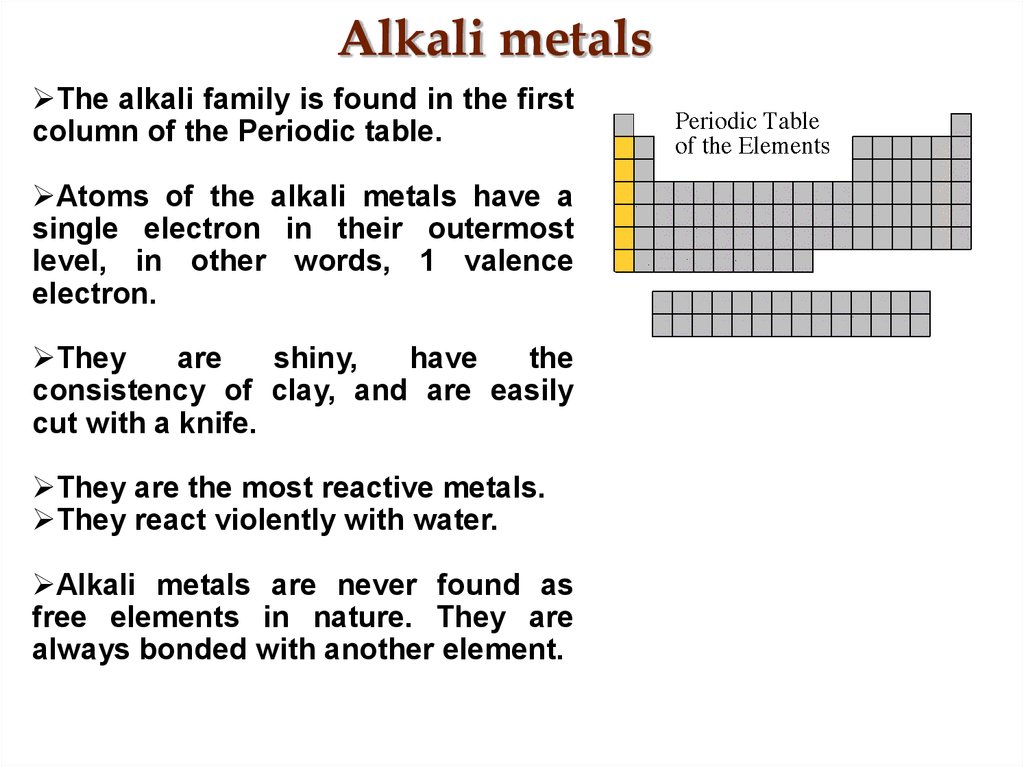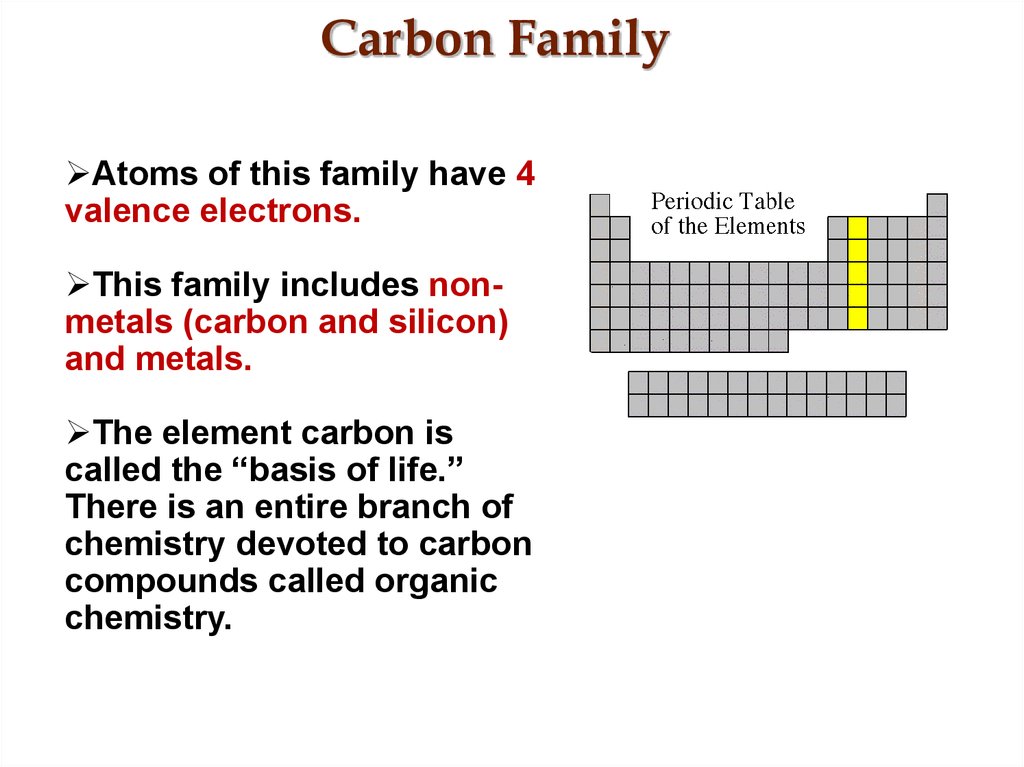Похожие презентации:
The Periodic Table
1. The Periodic Table
Elizaveta B. Borunova2. Vocabulary
electron arrangement(electron configuration)
shell
outer shell
valence electrons
energy level
orbital
charge
electronegativity
electron affinity
ionization potential
alkali metals
alkaline-earth metals
transition metals
halchogens
halogens
rare-earth elements
trend
3. Chemical elements
Non-metalsH – hydrogen
F - fluorine
O – oxygen
Cl - chlorine
N – nitrogen
Br - bromine
B – boron
I - iodine
Si –silicon
P – phosphorus
He -helium
S – sulfur, sulphur
4. Chemical elements
Metalssodium – Na
potassium – K
magnesium - Mg
iron – Fe
copper – Cu
silver – Ag
zinc – Zn
tungsten – W
manganese – Mn
lead – Pb
tin – Sn
mercury - Hg
5. The Periodic Table of Chemical Elements
What is the Periodic table ?
What information is obtained from the table ?
How can elemental properties be predicted by means of
the PT ?
6. Dmitri Mendeleev (1869)
D.I.Mendeleevgrouped
elements
according to their atomic mass, and as
he did, he found that the families had
similar chemical properties.
Blank spaces were left open to add the
new elements he predicted would occur.
http://www.chem.msu.su/eng/misc/mendeleev/welcome.html
7. The Periodic Table
Henri Moseley (England,1887-1915) established that eachelements has a unique atomic number, which is how the
current Periodic table is organized.
Mendeleev:
"The properties of elements, as well as its compounds are
periodic function of the their atomic weight.“
Modern formulation:
“The properties of chemical elements, as well as the forms
and properties of the compounds of the elements are
periodic function of the nuclear charge of atoms of the
chemical elements”.
Periodic changes of chemical properties of elements can be explained
by the correct repetition of electronic configuration of external
energy level (valence electrons) of their atoms with increasing charge
of nucleus.
8. The latest version
The International Union of Pure and Applied Chemistry hasannounced the names of four elements in the Periodic table
that were discovered in January 2016. Moscovium (Mc),
nihonium (Nh), tennessine (Ts) and oganesson (Og) complete
the seventh row of the table. The elements — with atomic
numbers 113, 115, 117 and 118 — were discovered in a joint
effort by American and Russian scientists.
9. Periodic Table: Metallic arrangement
Layout of the Periodic Table: Metals vs. nonmetals1
IA
1
18
VIIIA
2
IIA
13
IIIA
14
IVA
15
VA
16
VIA
17
VIIA
2
3
4
5
6
7
3
IIIB
4
IVB
5
VB
6
VIB
7
VIIB
8
9
VIIIB
Metals
10
11
IB
12
IIB
Nonmetals
10. Periodic Table: The three broad Classes Main, Transition, Rare Earth
Main (Representative), Transition metals, lanthanides and actinides (rare earth)11. Across the Periodic Table
Periods: are arranged horizontally across theperiodic table (rows 1-7)
These elements have the same number of valence shells.
1
IA
1
2
IIA
13
IIIA
2nd Period
2
3
3
IIIB
4
IVB
5
VB
6
VIB
4
5
6th Period
6
7
7
VIIB
8
9
VIIIB
10
11
IB
12
IIB
14
IVA
15
VA
18
VIIIA
16
VIA
17
VIIA
12. Down the Periodic Table
Families (groups) : are arranged vertically down theperiodic table
( 1- 18 or 1-8 A,B)
These elements have the same number electrons in the
outer most shells, the valence shell.
1
IA
1
18
VIIIA
Alkali Family:
1 e- in the valence shell
2
IIA
13
IIIA
14
IVA
15
VA
16
VIA
2
3
3
IIIB
4
IVB
5
VB
6
VIB
7
VIIB
8
9
VIIIB
10
11
IB
12
IIB
4
5
6
7
Halogen Family:
7 e- in the valence shell
17
VIIA
13. Notable Families of the Periodic Table
AlkaliAlkaline
(earth)
1
IA
1
Halogens
Chalcogens
18
VIIIA
2
IIA
13
IIIA
Transition Metals
2
3
4
5
6
7
3
IIIB
4
IVB
Noble Gases
5
VB
6
VIB
7
VIIB
8
9
VIIIB
10
11
IB
12
IIB
14
IVA
15
VA
16
VIA
17
VIIA
14. Important members - the Elements
1IA
1
H
2
Li
3
4
5
6
7
18
VIIIA
2
IIA
Na Mg
K
Ca
13
IIIA
3
IIIB
4
IVB
5
VB
6
VIB
7
VIIB
8
Fe
9
VIIIB
10
11
IB
12
IIB
Cu Zn
Ag
14
IVA
15
VA
16
VIA
17
VIIA
C
N
O
F
Al Si
P
S
Cl
Br
I
He
15. The Periodic Table
16. Orbitals
An atom is composed of a nucleus containing neutrons and protonswith electrons dispersed throughout the remaining space. Electronic
orbitals are regions within the atom in which electrons have the highest
probability of being found.
Each orbital has its own specific energy level and properties. Because
each orbital is different, they are assigned specific quantum
numbers: 1s, 2s, 2p 3s, 3p,4s, 3d, 4p, 5s, 4d, 5p, 6s, 4f, 5d, 6p, 7s, 5f,
6d, 7p. The numbers, (n=1,2,3, etc.) are called principal quantum
numbers and can only be positive numbers. The letters
(s,p,d,f) represent the orbital angular momentum quantum number.
17. Periodic Table: electron behavior
Elements can be classified by the behavior of their electronsWest (South)
METALS
Alkali
Alkaline
Transition
These elements
tend to give up
e - and form
CATIONS
1
IA
1
Mid-plains
METALLOID
These elements
will give up e- or
accept e-
East (North)
NON-METALS
Noble gas
Halogens
Calcogens
These elements
tend to accept
e - and form
ANIONS
2
IIA
13
IIIA
2
3
4
5
6
7
3
IIIB
4
IVB
5
VB
6
VIB
7
VIIB
8
9
VIIIB
10
11
IB
12
IIB
14
IVA
18
VIIIA
15
VA
16
VIA
17
VIIA
18. Trend in Atomic Radius
Atomic Radius:The size of at atomic specie is
determined by the boundaries of the
valence e- layer. Largest atomic
species are those found in the SW
corner since these atoms have the
largest n, but the smallest Zeff.
19. Trend in Ionization Potential
Ionization potential:The energy required to remove the
valence electron from an atomic
specie. Largest toward NE corner
of PT since these atoms hold on to
their valence e- the tightest.
20. Trend in Electron Affinity
Electron Affinity:The energy release
when an electron is
added to an atom.
Most
favorable
toward NE corner
of PT since these
atoms have a great
affinity for e-.
21. Summary of Trends
Ionization Energy: Largest toward NE of PTElectron Affinity: Most favorable NE of PT
Atomic Radius: Largest toward SW corner of PT
22. Summary of Trends
On the position of element in the Periodicsystem possible to forecast its basic
properties, as average of all its neighbors:
23. Summary
Periodic Table: Map of the Building blocks ofmatter
Types: Metals and Nonmetals
Families: Elements in the same column have
similar chemical properties because of similar
electronic configuration of the outer shell.
Alkali, Alkaline, chalcogens, halogens, noble gases
Periods: Elements in the same row have valence
electrons in the same shell.
Groups: Elements in the same group have the
same number of valence electrons .
24. Hydrogen
The hydrogen square sitsatop Family AI, but it is not a
member
of
that
family.
Hydrogen is in a class of its
own.
It’s
a
gas
at
room
temperature.
It has one proton and one
electron in its one and only
energy level (s-orbital).
Hydrogen only needs 2
electrons to fill up its valence
shell.
25. Alkali metals
The alkali family is found in the firstcolumn of the Periodic table.
Atoms of the alkali metals have a
single electron in their outermost
level, in other words, 1 valence
electron.
They
are
shiny,
have
the
consistency of clay, and are easily
cut with a knife.
They are the most reactive metals.
They react violently with water.
Alkali metals are never found as
free elements in nature. They are
always bonded with another element.
26. Alkaline Earth Metals
Alkalineearth metals
include magnesium and
calcium, among others.
They have 2 valence
electrons.
They are active metals.
They are never found
uncombined in nature.
27. Transition Metals
Transition Elements include thoseelements in the B families.
Transition elements have 1 or 2 valence
electrons, which they lose when they form
bonds with other atoms. Some transition
elements can lose electrons in their next-tooutermost level.
Low ionization energies
Positive oxidation states, multiple
oxidation states, since there is a low
energy gap between them
Very hard
Exhibit metallic luster
High melting and boiling points
High electrical conductivity
High thermal conductivity
Malleable
Form colored compounds, due to d-d
electronic transitions
Typically exhibit high catalytic activity
28. Boron Family
The Boron Family is namedafter the first element in the
family.
Atoms in this family have 3
valence electrons.
This family includes a
metalloid (boron), and the rest
are metals.
This family includes the
most abundant metal in the
Earth’s crust (aluminum).
29. Carbon Family
Atoms of this family have 4valence electrons.
This family includes nonmetals (carbon and silicon)
and metals.
The element carbon is
called the “basis of life.”
There is an entire branch of
chemistry devoted to carbon
compounds called organic
chemistry.
30. Nitrogen Family
The nitrogen family isnamed after the element that
makes up 78% of our
atmosphere. Other elements
in this family are phosphorus,
arsenic, antimony, and
bismuth.
Atoms in the nitrogen family
have 5 valence electrons.
They tend to share electrons
when they bond.
This family includes nonmetals and metals.
31. Oxygen Family
Atoms of this family have 6valence electrons.
Most elements in this family
share electrons when forming
compounds.
Oxygen is the most
abundant element in the
earth’s crust. It is extremely
active and combines with
almost all elements.
32. Halogen Family
Halogens have 7 valenceelectrons, which explains why
they are the most active nonmetals. Halogen atoms only
need to gain 1 electron to fill
their outermost energy level.
They are never found free in
nature.
33. Noble Gases
Noble gases are colorlessgases that are extremely unreactive.
They are inactive because
their outermost energy level
is full (8 electrons).
Because they do not readily
combine with other elements
to form compounds, the
noble gases are called inert.
Noble gases are found in
small amounts in the earth's
atmosphere.
34. Rare Earth Elements
The thirty rare earthelements are composed of
the lanthanide and actinide
series.
One element of the
lanthanide series and most
of the elements in the
actinide series are called
trans-uranium, which
means synthetic or manmade.
35.
Thanks for your attention!http://www.periodictable.com/



































 Химия
Химия








